By Maxine Cart-Lome
Collectors will tell you it’s the thrill of the hunt for what they love that drives their passion for collecting. That’s certainly true among bottle collectors, who have many places to look and dig through to find their treasures outside of antique shops, eBay, auction houses, flea markets, and bottle dealers. Whether it’s an appreciation for the art form or for the history, or both, bottles and how they are found tell interesting stories. Here are a few off-the-beaten path places to look, their stories, and a sample of what has been found:
Glass Bottle Beach
First a horse rendering plant, then a 19th century landfill, Dead Horse Bay in Brooklyn, NY is a glass digger’s paradise of century-old bottles.
Dead Horse Bay got its name sometime in the 1850s, when horse-rendering plants surrounded the beach. From the 1850s until the 1930s, the carcasses of dead horses and other animals from New York City streets were used to manufacture glue, fertilizer, and other products on the site. As the car industry grew, horses and buggies-thus horse carcasses-became scarce, and by the 1920s there was only one rendering plant left.
It was during this era, around the turn of the century, that the marsh of Dead Horse Bay began to be used as a landfill, which was capped in the early 1930s. The cap burst in the 1950s and since then garbage has been leaking continually onto the beach and into the ocean, including thousands upon thousands of broken and intact bottles, many over 100 years old!
“Glass Bottle Beach,” as it is now known, is open to the public for picking (if you can stomach some of the other remnants of Dead Horse Bay’s pungent past). Reader and casual collector Laurie Kantor of Long Beach, NY shares these photos from an April 2018 trip to Dead Horse Bay. “I’ve always loved glass, and I used to make stained glass as a hobby,” said Laurie Kantor. “I read about Dead Horse Bay in Brooklyn several years ago and was interested in going there but had trouble convincing my husband to accompany me. We have a tradition that on my birthday I get to choose where we go so this year we went to Dead Horse Bay! I was sure there would be nothing left by the time I got there, but as you can see from the pictures, there are plenty of bottles left! I could not stop myself from picking up the glass, until it got too heavy to carry. A lot of the bottles have embossed lettering giving clues to what they were used for in the past. There is a tide at this bay but not strong waves, so there were many items intact and not worn down by the elements.”
Privy Digging
Interesting bottle finds turn up in the most unusual places, as any privy digger will tell you. Privy digging is a form of historical digging in defunct outhouse vaults to salvage antique bottles and everyday household artifacts from the past. Privy digging is directly linked to antique bottle collecting; however, the high percentage of broken items typically found in a privy is one reason why privy digging is one of the most unpredictable and arduous methods of attempting to form a bottle collection.
Since there was no garbage removal in the 1800s, household trash-empty bottles, old dishes, tins, and the like-were typically thrown out in the outhouse. Once a house’s pit got full, it would be topped off with dirt and forgotten as the grass overtook it, and the outhouse itself would be moved over another hole somewhere else in the yard. The most common locations for the privy were directly out the back door, along the property line, in the back or rear middle of the lot, or the middle of the yard. Some pits lasted five or 10 years; others not so long, based on how quickly they filled up and how deep they were dug. Glass or clay bottles are the most likely items to be found in an average 19th century privy.
The bottles unearthed at these sites tell a lot about the people who used them. The medicine bottles they bought and discarded show the diseases they caught and tried to cure. Glass inkwells in the pits indicate their owners could read and write. A large number of liquor bottles strongly suggest they drank to excess. A stash of certain medicine bottles hint that the owners had an unhealthy taste for opiates.
For those that have the stomach for privy digging, great finds, stories, and treasures await, as many a collector will tell you.
Archeological Digs
When a homestead or privy site is identified as historically significant, great finds get unearthed that add to our historical record.
In 2004 archaeologists at Historic Jamestowne uncovered a brick-lined cellar filled with 300-year-old intact glass wine bottles – one of the earliest wine cellars in America. Jamestown Rediscovery archaeologists found 10 onion-shaped glass bottles made in England between 1680 and 1700, clustered upright on the dirt floor near one wall of an 8 x 20 foot rectangular cellar. Other bottle fragments found in the area indicate there may have been as many as 30 wine bottles stored there. One of the intact bottles bears a glass seal with the initials “FN”, which indicates it belonged to someone of wealth and status. During the 17th century, it was customary for high-ranking gentlemen to order wine bottles from England stamped with their personal seal. It may be the mark of Francis Nicholson, the governor of Virginia from 1698 to 1705. He moved the capital from Jamestown to Williamsburg in 1699 after the last Jamestown statehouse burned in 1698. Though wine was the most likely use for the bottles, none of the intact bottles had corks or liquid remaining in them.
Excavation is currently underway at the site of Bisbee, Arizona’s Warren Ballpark, considered the longest continually operated ballpark in the country. While the record of ballplayers that came through the ballpark is impressive but well-documented, almost nothing is known about the fans that came to these games. Items such as clothing buttons, spent shells, seeds from discarded food, and fragments of glass bottles left behind by the fans in the stands provide new insight into Southwestern American life in the early 1900s. Automobile glass found in outfield trenches where wealthier fans could drive onto the outfield to watch the game from their cars is speculated to have come from foul balls. Markings on a pre-Prohibition fragment of a beer bottle unearthed and dated to somewhere between 1905 and 1917 indicate it was manufactured by Adolphus Busch and that it probably came from a factory in St. Louis. How did it get to Arizona?
Likewise, the team found an almost complete bottle, which was restored by a team at the Arizona State Museum and identified as a bottle of Purity Soda, made in Tucson, dating to 1926. Interesting story – six years later the owner of the Purity Soda Works was arrested for bootlegging leading to the question of how “pure” was the soda? This dig site continues to unearth new items, stores, and insights, with glass as our link to the past.
The excavation at the bastle house sites of Glenochar and Smithwood (homes built to house livestock on the first floor and the tenant farmers who owned them on the second) in the Daer Valley of Scotland unearthed one of the two largest collections of early 18th century wine, ale, and medicine bottles to be excavated in Scotland. These provide a glimpse into a lifestyle once thought to be quite spare, whereas the excavation reveals heavy use of ale, wine, tobacco, and food being served on fine Staffordshire slipware pottery. Shards of the bottles recovered during excavation were meticulously put in order and reconstructed into their original shape, although mostly as partial examples. The largest Smithwood wine bottle found has a capacity of 800ml.
Carried by the Current
Between 1864 and 1933, thousands of bottles were thrown into the world’s oceans from German ships, each containing a form on which the captain would write the date it was jettisoned, the exact coordinates at the time, the name of the ship, its home port, and travel route. On the back, it asked the finder to write when and where the bottle had been found and return it either to the German Naval Observatory in Hamburg or the nearest German Consulate. More than 600 of the message slips were returned, the last one (number 663) just discovered in January, 2018 nearly 590 miles from where it was tossed from the bark ship Paula (a 3-masted sailing ship) in the Indian Ocean during its trip from Cardiff, Wales to Macassar, Indonesia. The bottle was on a beach 164 feet from the shoreline at the high water mark on Wedge Island, Australia. Although the gin bottle was missing its cork, the message was intact and verified as the oldest bottle found to date, 132 years after its launch from the Paula. It is currently on display at the Western Australia Museum.
In the early 1900s, people were fascinated with the idea of sending out messages in a bottle. In 1914, a World War I soldier tossed a letter to his wife into the English Channel two days before being killed. It was recovered in 1999 and returned to their daughter. In 1916, the crew of a Zeppelin sent their final words as messages in bottles, and they were found on a beach in Sweden six months later. In 2012, one of the 1,890 messages in bottles that a scientist in Scotland cast into the ocean in 1914 to study currents was found. In 2014, a German fisherman pulled a 101-year-old message in a bottle out of the Baltic Sea. The message was written by a man named Richard Platz, and set to sea in 1913.
In 2013, a diver found a 97-year-old message in bottle buried in Lake St. Clair, Michigan, tucked in four to six inches of dirt in about 30 feet of water where the Tashmoo steamship once docked daily. The message was written and tossed overboard by two ladies, Selina and Tillie, aboard the Tashmoo, visiting Harsens Island on June 30, 1915. They wrote the date, their names and addresses in scrolling cursive with pencil on the back of a White Star Line ticket. The simple message on the back: “Having Fun at Tashmoo.” The bottle was so heavy that it is believed it sank where it was tossed, to be found 97 years later.
Sharing the Adventure
There are a number of websites and online pages where bottle diggers share their stories, insight, and bottle information with other enthusiasts. Here are a few:
Treasurenet.com/forums/bottles-glass
Westernbittersnews.com • Peachridgeglass.com
Ricksbottleroom.com • Utahbottles.blogspot.com
Antiquebottles-glass.com/learn/digging-antique-bottles
Oberk.com/antique-bottle-collector-resource-guide
On Facebook, you can look for these groups and pages:
Bottle Diggers and Collectors (mostly U.K. but a huge community of diggers)
U.S. Bottle Diggers and Collectors • Bottle Digging at its Best
Historical Bottle Diggers of Virginia • ESVA Bottle Diggers


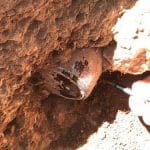

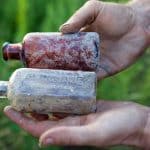
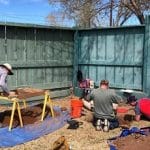
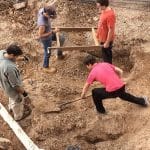


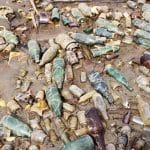


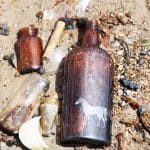

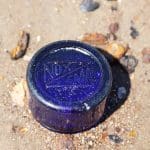

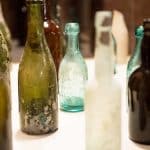
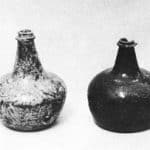
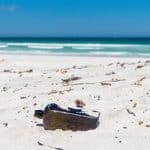
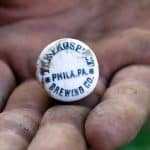
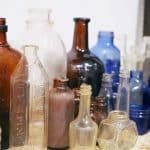



Related posts: